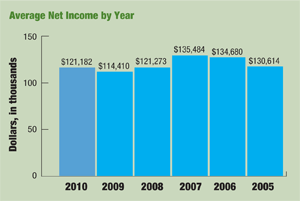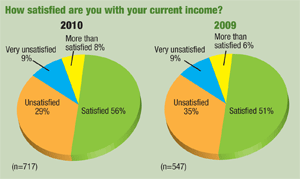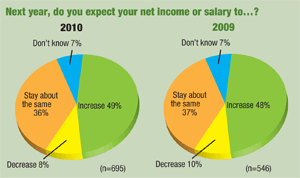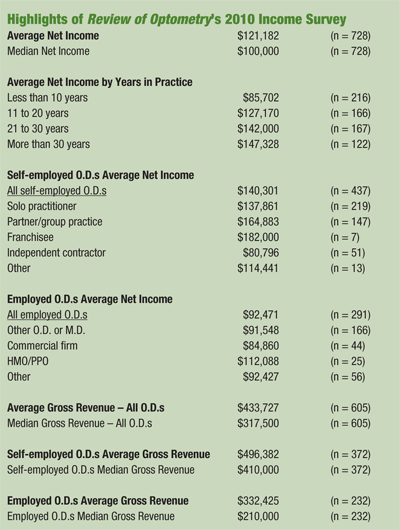 For the first time in what seems like a long time, the economic situation for optometrists looks optimistic. There’s a light at the end of the tunnel, and it’s not an oncoming train.
For the first time in what seems like a long time, the economic situation for optometrists looks optimistic. There’s a light at the end of the tunnel, and it’s not an oncoming train.
According to our latest optometric income survey, annual net income (including both employed and self-employed optometrists) rose from $114,410 in 2009 to $121,182 in 2010—an increase of 5.6%. That’s not quite as good as things were back in 2007 before the bottom fell out of the economy (and when net income averaged $135,484). But, it’s a start in the right direction.
“We continue to grow,” says Clark Jensen, O.D., a solo practitioner in Casper, Wyo. “This year is going better than last year, and last year was our best year ever.”
Another point of view: “I built a new building and opened just as the economy tanked,” says Todd Winbigler, O.D., of Boise, Idaho. But, he adds, “I live comfortably on my income. I am optimistic that we have a lot of room for growth and increased revenue.”
These are some of the highlights of Review of Optometry’s annual Income Survey. The survey was e-mailed to more than 30,000 readers. More than 6,700 viewed the e-mail, and 973 optometrists responded.
Satisfaction Returns
Income in 2010 has been an improvement over 2009. Not surprisingly, many optometrists were less than satisfied with their income in 2009. Indeed, salary satisfaction was just about at an all-time low. Only about half of respondents (51%) said they were “satisfied” with their 2009 income, and just 6% said they were “more than satisfied.” As many as 44% said they were either “unsatisfied” (35%) or “very unsatisfied” (9%).
But things bounced back in 2010. As many as 64% of respondents say they are “satisfied” (56%) or “more than satisfied” (8%).
“Given the present economy and how hard a time many people are having just getting a job, I feel lucky to be in a profession with such a steady income,” says Clark Weeks, O.D., of Winfield, Ala.
Meanwhile, fewer optometrists say they are “less than satisfied” (29%). Curiously, 9% of respondents in both 2009 and 2010 say they are “very unsatisfied.”
But the sour economy isn’t the only reason some O.D.s feel dissatisfied. Solo practitioner Paul H. McRae, O.D., in Carrollton, Ga., says it’s simply hard to make a living as an optometrist these days. “It’s barely enough to sustain a meager lifestyle. I didn’t spend eight years in college and more than $100,000 on an education to live like a factory worker,” he says.
Salary Specifics
While average net income for all O.D.s was $121,182 in 2010, that doesn’t tell the whole story.



For instance, optometrists who are self-employed (those in private practice, partnership, group practice, franchises or independent contractors) saw a nice jump of 9.6% from 2009 to 2010, from $127,981 to $140,301. That marks a resurgence toward pre-recession levels, when self-employed income was $151,548 back in 2007.
“The debt load to become an optometrist and purchase a practice takes a significant amount of my net,” says solo practitioner Ron Mearsha, O.D., of Greeley, Colo.
For optometrists who are employed (by another optometrist or M.D., a corporate firm, an HMO or PPO, or in other employment) average net income increased to $92,471 from $90,931 in 2009, an improvement of 1.7%. This, too, is an approach toward employed salary in 2008, which averaged $93,886 (but still not as good as in 2007, when employed salary averaged $107,899).
Employed optometrist Gregory Kipp, of Ormond Beach, Fla., states correctly that, “According to surveys that I read in publications like this, I make less than most of my peers.”
Dr. Kipp makes a good point. Very high or very low salaries may skew the results in surveys such as this one. So, median income—the midpoint of all responses—may provide a better snapshot of the typical O.D.’s income.
Median net income for all optometrists was $100,000 in 2010, compared with $93,000 in 2009, an increase of 7.5%. That’s good news.
(For average incomes in specific optometric settings, see “ Highlights of Review of Optometry ’s 2010 Income Survey”)
Be aware that we request and report net income, which is technically not the same as salary. Net income is gross income minus taxes. In other words, this is take-home earnings or net profit.
Also be aware that, for whatever reason, the number of experienced optometrists who participated in this year’s survey was slightly higher than before. We know that optometrists who’ve been in practice longer tend to have greater incomes, and this may have skewed the results toward higher revenue figures.
Nevertheless, the basic conclusion is the same: Optometrists overall appear to be making at least a little more income in 2010 than 2009.
Gross Holding Steady
Optometrists’ gross revenues have been on the decline since 2004, long before the current economic downturn. Good news: Average gross income is holding steady, according to our 2010 numbers. Gross revenue averaged $433,727 in 2010, compared to $433,646 in 2009.
For self-employed optometrists, gross revenue averaged $496,382 in 2010—an increase of about 2% from $486,794 in 2009.
For employed O.D.s, average gross revenue was $332,425 in 2010, which is a significant increase of 8% compared to $307,743 in 2009.
“I was once a teacher making $27,000 gross,” says Dionne Moore, O.D., M.A., who now works at the community outpatient clinic of the Louis Stokes Cleveland VA Medical Center, in Lorain, Ohio. “This is much better.”
 Economic Health is Viable
Economic Health is Viable
With expenses up and accounts receivables flat, it’s no surprise that profit margins are not rising, even while income is.
Profit margin is calculated as net income divided by gross revenue, and it’s commonly used to indicate a company’s economic health.
For optometrists, that “health” is tolerable, but not exactly robust. According to optometrists, profit margins have been about the same since 2008. More than half of optometrists (57%) say that their profit margin hasn’t changed. At the same time, 23% of respondents say their net in 2010 did increase as a percentage of gross, while 22% say it decreased.
What do they ascribe this to?
“People are spending less on eyewear. The cost of goods is higher and fixed costs are higher,” says Richard Miyamoto, O.D., of Gardena, Calif.
Adds Dr. Jensen, “I don’t know how to improve that percentage without laying off staff or cutting pay to staff members. I don’t know which costs to cut that are not necessary.”
Normal Business Hours
Optometrists are working as hard as ever—or maybe even just a wee bit less than last year. Optometrists’ average workweek in 2010 was 39.2 hours, compared with 39.7 hours in 2009.
Self-employed optometrists continue to work more than their employed colleagues, with an average of 39.6 hours per week for self-employed O.D.s and an average of 38.7 hours for employed docs.
“Although I know I could make more income by owning my own practice, there are some advantages of working as an employed optometrist, such as the benefits, paid holidays and vacation, and a flexible schedule that helps with raising children,” says Nicole Tradup, O.D., of the Washoe Tribal Health Center in Gardnerville, Nev. “Later, when the timing is right, I would like to own my own practice.”
May the Road Rise to Meet You
According to 2009’s income survey, optometrists were hopeful that 2010 would bring better news. And, for the most part, it has.
Likewise, optometrists who answered our current survey are largely optimistic about this year’s economic prospects. Nearly half (49%) expect their income to increase in 2011, while 36% hope it will at least stay the same. Only 8% expect a decrease.
But optometrists have learned to do more than hope and dream; they have ways and means. Here are some of their practical ideas to improve income in the coming year:
- “Continue to provide more medical eye care and rely less on material sales,” says Larry Cusma O.D., of Scotia, N.Y.
- “Add a full-time associate to the practice,” says Jeff Whittington, O.D., of Charleston, W.Va.
- “Take care of staff members,” Dr. Jensen says. “We bonus our staff when we have a good month so they have an incentive to do the best job possible. Last month, that bonus added an extra $2 per hour to their paychecks.”
 “Pay off practice debt, and increase the number of patients per hour,” says Jessica Heinke, O.D., of Woodstock, Ill.
“Pay off practice debt, and increase the number of patients per hour,” says Jessica Heinke, O.D., of Woodstock, Ill. - “I became Paragon CRT certified and have been getting many referrals for CRT,” says Sabrina Gaan, O.D., of Medfield, Mass. “Also, we’re doing more company health fairs to promote business.”
- “I’m moving into a new building, improving my optical dispensary and investing in more technology in my office,” says Susan Perdue, O.D., of Birch Run, Mich. “Hopefully all this investment will increase my profitability.”
- “Increase professional service appointments and medical office visits to offer diagnostic care using OCT, HRT, retinal photos, etc.,” says Frederick W. Scarpace, O.D., of Dearborn Heights, Mich.
- “By not taking Medicaid, that in itself has made our practice distinctive. Instead of a two- to three-month wait for an appointment, our wait may only be two to three days, and we are able to take walk-ins,” says Mario R. Barrera, O.D., of Laredo, Texas. “Some of those walk-ins will spend $2,000, and come back in a year and a half and do the same thing again.”
- “Drop some of the vision plans that are more trouble to collect and less profitable than they should be,” Dr. McRae says. “We’ll market more toward private pay patients and increase our activity with social media.”
- “Continue to make patients happy, one at a time,” says Patrick McKernan, O.D., of King of Prussia, Pa. “Happy patients equal continued referrals.”

